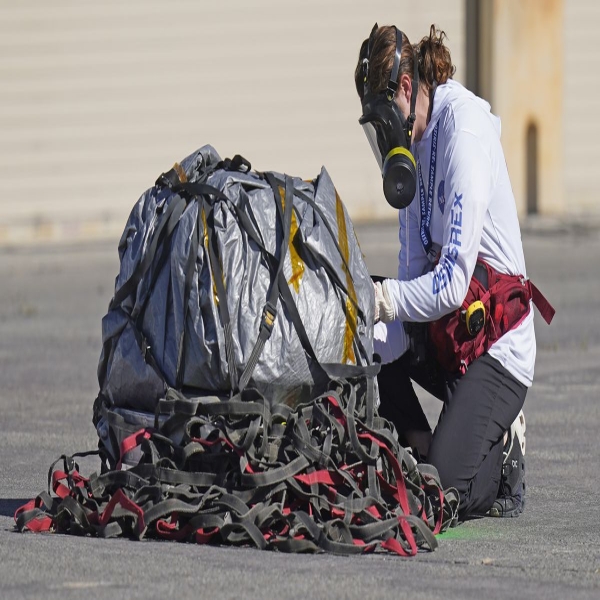The OSIRIS-REx spacecraft arrived in Utah Sunday, carrying material from the dawn of the solar system.

Ellen Ioanes covers breaking and general assignment news as the weekend reporter at Vox. She previously worked at Business Insider covering the military and global conflicts.
A capsule bearing soil from an asteroid located 200 million miles from Earth landed in Utah at 8:52 am Mountain time Sunday, bringing with it — scientists hope — information about the origin of life.
The NASA spacecraft OSIRIS-REx, which stands for Origins, Spectral Interpretation, Resource Identification, Security-Regolith Explorer, delivered a sample of material from the asteroid Bennu. The space rock is estimated to be around 4.5 billion years old — meaning it formed around the same time as the solar system and likely holds pre-solar material, as well as amino acids, the building blocks of life.
Seven years after its initial launch, OSIRIS-REx deposited the capsule of uncontaminated material from Bennu to the Department of Defense’s Utah Test and Training Range, about 80 miles from Salt Lake City, before heading off on another mission, this time to the near-Earth asteroid Apophis.
What Bennu can tell us about some of life’s biggest questions
After the sample landed, the OSIRIS-REx team connected it to a 100-foot cable dangling from a helicopter for transport to a temporary clean room free from contaminants in the Earth’s atmosphere, where it will be preserved with nitrogen and then transported to Johnson Space Center in Houston.
Parts of the sample will then be shipped to other research labs, and some will also be preserved for future generations of scientists to study — similar to how today’s researchers still study samples of material from the moon brought back decades ago on Apollo 11, humanity’s first moon landing.

Researchers believe that material from asteroids like Bennu deposited compounds such as amino acids on Earth before life existed on this planet, Philipp Heck, senior director of research and curator of meteoritics and polar studies at Chicago’s Field Museum, told Vox. “We hope the Bennu samples will help us address the question, ‘Which building blocks were delivered by meteorites?’”
Even further back, Bennu could tell scientists about how planets, including Earth, formed in the first place. “Asteroids are [leftover] rocky material from the time of the solar system formation. They are the initial bricks that built the planets,” Fred Jourdan, a planetary scientist at Curtin University in Perth, Australia, told Space.com in July.
The asteroid sample — called a regolith — is the first ever brought back to Earth by a US team. Japan’s space agency led a mission that returned a sample from the asteroid Ryugu in 2020, which yielded important scientific information but was fairly small, limiting its utility. The Bennu sample is between 5.26 and 12.34 ounces (149 to 350 grams), scientists estimated from monitoring the collecting mechanism aboard the spacecraft.
That will be enough not only for today’s cosmochemists to study the makeup of Bennu, but also for scientists for years and even decades to come, who will be “able to address science questions that we cannot even ask today,” Heck said. “That’s really the power of sample return.”
Bennu is made from many of the same materials as meteorites that occasionally slam into Earth — which scientists find important to study, too, because they can help us understand what existed at the dawn of the solar system. But in those natural experiments, it’s difficult to distinguish what was already present in the meteorites’ material from what was deposited after they entered Earth’s atmosphere and biosphere, Heck explained. To avoid this problem, the Bennu sample was gathered directly from the asteroid and carefully sealed to avoid alteration by outside materials, even once it arrived on Earth.
Bennu was chosen for the OSIRIS-REx project because of its composition — which scientists could determine from observing the asteroid from a distance, as well as studies of similar space rocks — but also because it’s relatively close to Earth. “Every six years, Earth overtakes Bennu … so it’s a good opportunity to fly to Bennu with a reasonable investment in propulsion,” Heck said. “You don’t want to go to an asteroid that is too far away, then come back — it just costs so much more money to have a spacecraft that can do that.”
Because it’s a near-Earth asteroid, there is also “non-zero probability” that Bennu could hit Earth, Heck said, although that wouldn’t happen this century. “That was another motivation, to get to know the properties and the build-up of Bennu in case something like Bennu [could] at some point be on a collision course with Earth,” he told Vox. “We would have a better way to figure out how to deflect it, if we know what it’s made of.”
Heck expects that material from the sample will arrive to his research team in Chicago for study later this year. “Our labs are ready for it,” he said.
Source: vox.com






